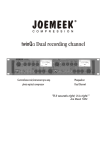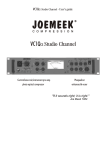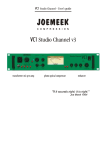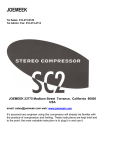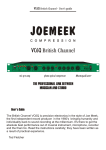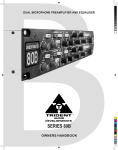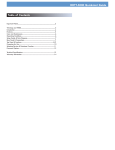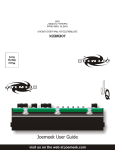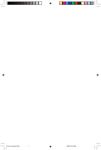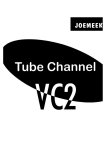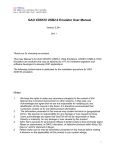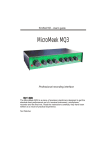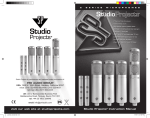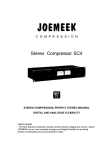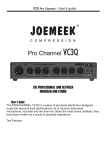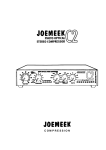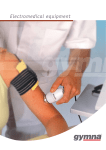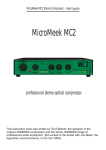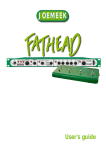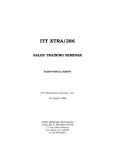Download JOEMEEK - Studio Manuals
Transcript
JOEMEEK SC2.2v4 Stereo Compressor - User's guide JOEMEEK C O M P R E S S I O N Stereo Compressor SC2.2v4 The classic JOEMEEK stereo compressor The classic JOEMEEK compression sound JOEMEEK SC2.2v4 Stereo Compressor - User's guide 1 JOEMEEK SC2.2v4 Stereo Compressor - User's guide INSTRUCTION BOOK CONTENTS The JOEMEEK SC2.2 - Limiting and compression 3 Controls and explanations - Controls - Connections - Initial operation - Operational control explanations 5 6 7 7 Problems 9 The JOEMEEK Photo optical compressor - What it does 10 Regulations and safety 11 Tips on use 12 Warranty statement - Declaration of conformity 13 14 Ted Fletcher This instruction book was written by Ted Fletcher; the designer of the original JOEMEEK compressor and the whole JOEMEEK range of professional audio equipment. Ted worked in the studio with Joe Meek, the legendary record producer, in the mid 1960s. 2 JOEMEEK SC2.2v4 Stereo Compressor - User's guide JOEMEEK Photo Optical Stereo Compressor SC2.2 The ORIGINAL JOEMEEK stereo compressor that now has additional features: 'Dark'/'normal'mode switch Hard wired bypass facility LIMITING AND COMPRESSION Why is the JOEMEEK different to a modern high tech. compressor limiter? It was designed as a stereo effects compressor rather than a 'levelling amplifier' as the early compressors were called. These are the basic definitions: A LIMITER is a device which stops the output of a signal path going above a predetermined level. A COMPRESSOR is a device which reduces the dynamic range of programme material. A 'perfect' compressor is an amplifier where the input/output ratio is constant: So using a 2:1 compressor, increasing the input by 2dB gives a corresponding 1dB increase in the output. Early compressors which used variable mu thermionic tubes or photoelectric devices only approximated true compression over a limited range. They had a soft 'threshold' where compression started and held to a predictable ratio up to a certain level, then they returned to a more linear amplification allowing transients through. This is in stark contrast to modern VCA compressor/limiters where designers thought it 'sensible' to combine the functions of compressor and limiter and to 'stonewall' any and all signals above a certain level. The musical effect is that (I know I'm over simplifying) VCA compressors sound muddy and flat, while old compressors sound lively and retain sparkle. 3 JOEMEEK SC2.2v4 Stereo Compressor - User's guide ITS HORSES FOR COURSES, a good VCA compressor limiter will do a good job making medium wave radio sound a bit louder and protecting a radio transmitter from exploding, but it is a poor tool for making a voice track stand out. The JOEMEEK compressor was designed to use the apparent deficiencies of the older technology providing a powerful artistic tool for the creative engineer. Joe Meek used to say, "If it sounds right, it is right!". To a lot of his contemporaries he went way over the top with overloading the record electronics on his 'Lyrec' 2-track recorder, and swathing his lessthan-perfect singers in bathroom echo and reverb, but his artistic use of non linear compression was masterly. 4 JOEMEEK SC2.2v4 Stereo Compressor - User's guide CONTROLS & EXPLANATIONS INPUT GAIN sets the audio gain of the stereo compressor. It's calibrated 1 to 11. With the control set at number 5 , the gain through the compressor is about 0dB (no gain). With the control at maximum, the gain is about 20dB. 'DARK MODE gives the option of using a 'conventional' sounding compression effect, or the more dramatic and original 'JOEMEEK' sound. The switch changes the characteristic of the release control making the time curve for the release of the compression behave in a much less linear or predictable way when in the special 'DARK MODE' (light is lit in this mode). Keeping shorter release times will increase the ‘DARK’ effect! SLOPE alters the amount that the optical system affects the audio signal. It approximates to a ratio switch in a conventional compressor; but don't take this too literally. At 1, the compression is light and the maximum possible compression is about 6dB. At 5, the compression can be severe. The compressor behaves in a similar way to a valve (tube) limiter. The intermediate positions give a range of compression effect. COMP/VU switch changes the mode of the meter. In 'COMP' mode, the needle sits at '0' and indicates approximate amount of compression by moving downwards. IN 'VU' mode, the meter shows audio level before the output gain control. COMPRESSION is the drive control to the optical system. It sets the point at which the compression starts; it specifies where the 'knee' is (although with a photo optical compressor, the knee is not well defined as the compression ratio varies with audio level). The effect of this control is a threshold control that increases the overall compression effect. IN/OUT switch literally switches the whole compressor in and out of circuit. When the switch is 'out' and the red LED is alight, the audio signal goes directly from the input connectors to the output connectors... There is no electronics in the way, and therefore the input and output gain controls will 5 JOEMEEK SC2.2v4 Stereo Compressor - User's guide be bypassed. When the switch is 'in', the input audio signal goes via the compression circuitry and is converted to 'sum and difference' mode. This ensures that the centre image stays perfectly in the centre even under heavy compression. The sum and difference coded signal is compressed, and then converted back into 'left/right' format. The 'hard wired' by-pass switch allows instant comparison between the original uncompressed signal, and the compressed processed signal. ATTACK sets the time for the compression to act. When set to 'fast' the attack time is slightly less than 1 millisecond. At 'slow', the attack time is increased to about 15 milliseconds. RELEASE is one of the most important and noticeable controls of the compressor. At minimum 'fast', the release time is less than 200 milliseconds. the range of the control is about 5 seconds. Fast releases make the compression effect more noticeable and more 'urgent' sounding. This control reacts differently depending on the status of the 'dark' switch. In normal mode, the compression release is smooth and linear, in 'dark' mode, the release starts gently, but releases quickly as the gain approaches normal; this gives an even more 'urgent' type of sound and often adds an apparent depth to the sound. OUTPUT GAIN controls the gain of the final output driver amplifiers. Normal position is marked as '0'. The control can be used to set the optimum volume level for driving any other equipment. The output level range is high (maximum output can be as high as +26dB) but the gain circuit is designed so that when the gain is turned down, the residual noise drops with the signal making an extremely quiet system. CONNECTIONS Inputs and outputs are balanced line level but can be operated unbalanced without loss of quality. If using unbalanced circuits, it is essential to ground the unused audio connection, ie; pin 3 on the XLRs. The XLR Inputs are high impedance and outputs are low impedance (as is normal for all good outboard equipment). 6 JOEMEEK SC2.2v4 Stereo Compressor - User's guide INITIAL OPERATION Connect inputs and outputs and plug in mains cable When the unit is powered, the meter needle will be at '0' if the meter switch has been left in the 'compress' mode, otherwise, it will rest at the minimum position (if there is no input program material). Either the red or the blue in/out status indicator will be on. The red indicates 'by-pass' where the compression circuit is switched out and the audio signals are directly connected from the input connectors to the output connectors. Compression is active when the blue light is on. Set the controls as follows: SLOPE to number 3 IN/OUT SWITCH to 'IN' (blue light) ATTACK to fast; full anti-clockwise. RELEASE to medium; halfway OUTPUT GAIN CONTROL set to the 'zero' mark. Feed some programme material into the unit and set the 'STEREO INPUT GAIN' control to about number 5; this will correspond to about 10dB gain. Set the output to match the equipment being driven. (professional studio equipment is normally +4 or 0dB. less expensive equipment is often -10dB) Switch the meter to 'compression', turn up the 'COMPRESSION' control slowly and, if there is sufficient audio signal, the meter will start to indicate compression by the needle moving downwards. The compressor should now be working and your ears can take over. OPERATIONAL CONTROL EXPLANATIONS There are two main gain controls on the compressor; the input gain control and the output gain preset control. The input gain control is a simple stereo ganged control that sets the audio gain of the front end amplifier. At maximum, the gain of the unit is about 20dB. So if you set the gain to say 10dB and wind in compression until the output is back at 'zero', you have 10dB true compression. The output gain control is to set the output to a comfortable level for the equipment it is feeding into. CAUTION; The compressor has gain, and a high output capability. If you hear signs of overloading it's likely that your mixer insert/input point is being overdriven. it's very unlikely that you are overdriving the compressor: Try turning down the output volume. 7 JOEMEEK SC2.2v4 Stereo Compressor - User's guide 'SLOPE' This control alters the ratio of compression. In practice, '1' is very gentle compression while '5' can give severe 'pumping' effects. I find that '2' or '3' is right for voice and for overall effect, while the higher numbers are better for instruments. 'COMPRESSION' simply adds gain to the compression sidechain. In simple terms this changes the 'threshold' of the compression although with this compressor the 'threshold' is not clearly defined; the compression starts very gradually and the compression ratio changes with programme content and amplitude. For practical purposes, winding up the compression control increases the amount of compression. In use you will find that musically, all controls are interrelated. The optimum position for the compression control is usually around '7' or '8'. 'ATTACK' sets the time that the compressor takes to act. At minimum (fastest) it's possible to make it 'overshoot' on some percussive programme material: This means that the compression electronics are driven hard before the gain has been controlled by the light cells. The cells catch up and overcompress momentarily giving a tiny dip immediately following the start of the 'note'. This is best demonstrated by using a drum track and setting the slope to '5', and attack and release to fastest. Used sparingly this can contribute to musical drive. Slower attacks and releases are used where the compression needs to be less obvious. 'RELEASE' sets the time during which the path gain returns to normal after compression. Generally, the longer the time, the less obvious is the compression. 'DARK' SWITCH The original SC2 JOEMEEK compressor had a unique sound. This gave a stereo mix an excitment and urgency that had not been heard since the late 1950's and early 60's. One of the reasons for this sound was an unusual time curve when the compression was being released; very obvious on cymbal crashes. This unique sound has been recreated in the SC2.2, and it can be heard by pressing the 'DARK' switch. This switched was named by a famous American record producer who first described this JOEMEEK effect as a 'dark' sound. 8 JOEMEEK SC2.2v4 Stereo Compressor - User's guide PROBLEMS 1) Got signal going through but no compression. In/out switch? Is there enough volume level going in? Is your stereo signal in phase? (If it's exactly out of phase, the compressor will not work). 2) It's noisy. The compressor itself is extremely quiet, but by definition compressors raise the level of quiet passages; this also means that if there is noise on the original, there will be more noise on the compressed signal. It's a compromise. 3) It distorts. No it doesn't! Distortion inside the compressor is virtually impossible, however it is possible to drive your insert point too hard. Try reducing the input gain control and winding up the compression a bit more. 4) I can't make the compression gentle enough! It takes practice. The setting of the Attack control close to fastest is quite critical, as is the compression control. 5) It won't pump hard enough! Again, it takes practice getting the gain control in the right range. Set the slope on '4' and the attack and release at minimum, then don't drive it too hard. Work the input gain and the compression controls until its right. 6) One side is louder than the other! It's most likely that you have a wiring or plug problem. If you plug an input or an output with a bad connection on either pin 2 or pin 3, then it will sound OK but be just low in volume; unlike other equipment. These SC2.2 compressors are carefully checked at the factory and it is virtually impossible for there to be an electronic gain error! 9 JOEMEEK SC2.2v4 Stereo Compressor - User's guide THE JOEMEEK PHOTO OPTICAL COMPRESSOR; WHAT IT DOES. Anyone who has tried to record a human voice in the simplest possible way has found that the dynamics of real world speech and music are impossible to handle with a 'linear' recorder: Even if the signals do not overload, the final result is a recording that seems to be thin, quiet and too wide in dynamic range. Early analogue tape recorders had a built-in answer to the problem, Slightly overloading the record channel produced (predominantly) 2nd order harmonic distortion and some volume compression. This made recordings sound 'warm' and reduced the problems of dynamics. Unfortunately (?), modern recording mediums don't react that way; they produce an accurate reflection of the input with all its built in problems. Most thinking engineers know of these problems and correct with the use of equalisers (to change the psychoacoustic distance from the microphone), limiters (to reduce dynamic range at the louder end) and enhancers (to sparkle it up). And then find that it is extremely difficult and time consuming to get a warm and cosy sound**. Joe Meek, in common with all engineers, experimented with the limited facilities of the time (1960 - 1965) and came up with a way of enhancing the 'tape bend' effect with compression. The compressor he used was primitive in the extreme, but coupled with the compression distortion provided by the valve tape machines he had, the result was voice and music sounds that were unique and sold records by the million. I had to make some significant improvements in the way the early compressors worked to make the JOEMEEK acceptable to today's engineers, but now that they are in general use in top studios all over the world, the consensus is that the sound is right, and really does recreate the warmth and power of the old equipment without the side effects. There are probably hundreds of types of compressor/limiters on sale in the world, all struggling for a place in the market with extra knobs and facilities and all missing the fundamental point;- that a compressor is there to produce a psychoacoustic effect of power and dynamics. not to perform any protective function electronically; it's a creative tool. The JOEMEEK recreates the dynamics of the old analogue tape and compressor combination. The photo electric effect make precisely the right sound; and, because the attack, release and compression curve shapes are so complex and interrelated, it is not possible to create a software algorithm for it: So there will never be an accurate JOEMEEK plug-in! (The 'dark' switch setting 10 JOEMEEK SC2.2v4 Stereo Compressor - User's guide makes it even more unlikely!) ** The classic way is to use a U47 or similar large diaphragm capacitor microphone (like the JOEMEEK JM47); which in itself 'distorts' the sound with complex high frequency phasing across the diaphragm and some 2nd order distortion from the amplifier tube or FET. REGULATIONS AND SAFETY The JOEMEEK SC2.2 Compressor has been designed and built to conform to all known safety requirements in the world. Within the European Union the Compressor easily meets the requirements for electrostatic and electromagnetic emissions, and conforms to all safety requirements of the European Common Market. the 'CE' symbol on the rear of the unit indicates compliance. In the United States of America the compressor complies with UL requirements and uses UL approved components in all power supply functions. POWER SELECTION JOEMEEK Compressors are fitted with a mains voltage selector for easy change of input voltage. The fuse carriage can be pulled out and rotated to select to the local power voltage. * In the '115' position, the unit will operate between 95 and 125V AC. * In the '230' position, the unit will operate between 210 and 240V AC. The fuse can remain at 100mA for both ranges. POWER EARTH (GROUND) CONNECTION The centre (ground) pin of the IEC power connector is connected to the metal chassis of the compressor. The Audio ground is also connected to chassis. * The power system is double insulated throughout so that power ground may be lifted off if required without affecting safety in any way. 11 JOEMEEK SC2.2v4 Stereo Compressor - User's guide TIPS ON USE Some handy hints from the JOEMEEK studio and from around the world: VOICES. The compressor adds stability and depth to solo voices, it allows you to use less equaliser or enhancer and still retain the original sparkle of a recording made with a fine microphone. Over compression with fast attack times on voice will change the apparent tonal quality so listen carefully! Opto compression makes lead and background vocals jump out and command attention. Try recording first with a little compression, then adding more at a different release time on the mix. On final mixdown of solo voices, it's possible to use quite heavy compression on the voice alone to gain 'stability'. Set 'compression' near full, the attack to about halfway and the release to '9 0'clock' , this holds the voice forward without the compression being too obvious. PIANO. Tricky, use it very gently unless you want unusual effects! PERCUSSION. The JOEMEEK sound is supreme on a full drumkit. The danger is to use it too much too early, save heavy use for the mix. If you want heavy compression and for the cymbals to really swish, try leaving the kick drum out of the mix that goes through the compressor. Limit the kick separately (ideally with a Joemeek C2) then mix it back into the final mix. The SC2.2 is absolutely ideal for drums, the image stability gives the sound a control and perfect rigidity, the 'dark' switch adds a subtle depth. GUITARS. Wind it on! The depth and sustain make it a must. ORCHESTRAL. A little light 'tightening' of an orchestral sound will make it more present and warmer sounding and add body to string sounds. Usually it's best to leave the 'dark' switch set to 'normal'. Experiment widely with the attack control, the setting is very dependent on the rhythm and percussiveness of the musical material. ON THE MIX. Remember that big compressed sounds are a balancing act; if any instrument or sound in the mix is suddenly louder than others, it will kick down the level of all the rest. This is a very useful fact, but it tends to promote laziness in engineers! With the SC2.2 the sound stays bright and 'present' and it's possible to go much heavier with compression than with any other device; that's OK, but the initial balance gets more and more critical the heavier the compression gets! Experiment with the attack 12 JOEMEEK SC2.2v4 Stereo Compressor - User's guide control. SMALL GROUP RECORDING. Try compressing the backing but leave the bass outside the compression and compress it separately. GENERALLY, because the compressor is so extremely quiet and free of any nasty distortions, its quite OK to use it both on individual tracks, and on the mix, so I tend to use it individually on almost everything just to gain some individual warmth, then use it again on sub groups in the mix; so it pays to have more than one! Thanks for buying the compressor: I'm now enjoying hearing its characteristic sound on records and productions from all over the world. Ted Fletcher WARRANTY In the unlikely case of a breakdown, please return the unit in its original packing through the supplier. The unit will be attended to immediately and returned to your supplier. If any breakdown occurs (excluding physical mistreatment) within 12 months of purchase no charge will be made. 13 JOEMEEK SC2.2v4 Stereo Compressor - User's guide LOOK OUT FOR OTHER GREAT JOEMEEK PRODUCTS! THE JOEMEEK Jm47 ‘Meekrophone’ True condenser 1” gold diaphragm microphone, with a transformer coupling for supreme sound. Supplied with pictured shockmount, case and 5m cable. Classic EQ from Trident-MTA, the A-Range. Raw, inductive EQ from the 1960’s. An amazing sound. JOEMEEK VC1Q Studio Channel Professional current mode mic amp + compressor and enhancer/de-esser + EQ complete channel, optional digital output. Manufactured by: FLETCHER Electroacoustics Ltd. St Mary’s, Barton Road, Torquay, Devon. TQ1 4DP. ENGLAND. Tel: +44 (0)1803 321921 Fax: +44 (0)1803 321922 e-mail: [email protected] DECLARATION OF CONFORMITY. This analogue audio processing equipment conforms to the standards and requirements of the European Economic Community. The EC Harmonised standards that have been applied are; a) Electrical equipment (safety) Regulations 1994 (S.I. 1994/3260) b) Electromagnetic Compatibility Directive (89/336/EEC) incorporating (S.I. 1992/2372) "If it sounds right; it is right" Joe Meek, 1964 www.joemeek.net 14















